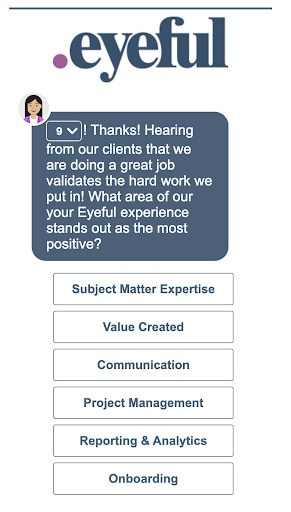How We Achieved a World Class NPS Score & Why NPS Matters for Small Businesses
People generally vote for ad agencies & other service companies with their wallets - they keep you around if they are happy and fire you if they aren’t getting what they need.
While our client retention rates are very high, feedback is an important part of our growth and continued improvement. We never want to be caught off guard and prefer to ask for feedback early and often.
Our NPS score is 92.3 — that’s considered a world-class score and well above the industry benchmark for digital agencies, which is 60.
Read on to learn how we capture customer feedback to reach this level of customer satisfaction.
For the first few years, we tried using a traditional web-based customer satisfaction survey. However, most clients wouldn’t fill it in, so it was hard to get a really good pulse on how people were feeling, what they loved, and what could be better. It also felt odd to send a form out on a regular basis - we knew there had to be a better way to gather insight at regular intervals.
I first learned about Net Promoter Score (NPS) when I was at Proflowers. We not only tracked NPS there but also understood the value of each point.
After leaving Proflowers, I brought NPS to a couple of companies, including Fossil, but it was something that seemed like a “big company” thing. As Eyeful Media started growing, I wanted to find a way to use it at our company, a small business.
Below are some details about Net Promoter Score, how we’ve used it to gather feedback from clients, and how we’ve helped clients capture their own NPS scores.
Table of Contents Show
What is a Net Promoter Score?
You may not be familiar with the term Net Promoter Score, but you’ve probably received an email that asks you whether you’d recommend a business or service to a friend or family member.
That single question is the basis for the Net Promoter Score, which is a measure of your client’s propensity to feel strongly about your business to tell friends about it, either positively or negatively.
How is NPS calculated?
Net Promoter Score is captured on a scale of 0-10, with 9 and 10 being promoters and 0-6 being considered demoters. A score of 7 or 8 is considered passive.
NPS scores are calculated by adding up your responses and subtracting the percentage of detractors from the percentage of promoters.
For example, if 70% of respondents are promoters, 10% are detractors, and 20% are passives, your NPS would be 70-10=60.
There’s a bit of a debate on whether 70 or 80 NPS is considered world-class, but anything over 50 is excellent.
Why is NPS important for a small business?
When you’re small and growing, every customer truly matters and perceptions can change over time. We now poll both current and past customers every quarter to see how they are feeling overall, but we also ask them for feedback - good and bad.
By and large, we see 9 and 10 scores (positives); however, on occasion, we see something lower. That’s a great reason to reach out to a client to better understand what is frustrating them and how you, as a company, can make things right.
How to improve your NPS score
The best way to improve your NPS score is to capture feedback alongside it and reach out to clients quickly to understand the cause of their frustration or disappointment.
A couple of months ago, we received a score of 6 from a private equity client that had given us a 10 the previous quarter. What was odd was that we hadn’t done any new work for them since that project, so I was confused about what had changed his perception.
Upon seeing the score, I immediately reached out and learned that his score wasn’t a reflection of his perception but more so something he had heard from a company we had evaluated on his behalf. They had been surprised by our use of third-party SEO tools for the analysis.
We realized that the confusion was due to a misperception the evaluated company had about the deliverable and our charter. The PE firm hired us to conduct a due diligence assessment, however, the company thought were hired to do an SEO audit.
Those two deliverables are extremely different, with one focused on a risk assessment and upside relative to competitors and the other going much deeper into SEO. Due diligence usually takes one week and is done on short notice, whereas a proper audit can take much longer.
We clarified the confusion for the private equity partner, and one week later, he gave us a new SEO audit & diligence project. This project allowed us to show him the depth of our SEO work and changed his perception quickly.
If we hadn’t sent an NPS survey the quarter after his project wrapped up, we would have never had the opportunity to clarify things with him and wouldn’t have had a shot at another project.
In this case, measuring the score, reaching out directly with a personal email, and understanding the issue led to a new perspective.
Fixing that one situation alone has paid for years and years of our net promoter score survey capture technology! It was an amazing ROI.
We’ll be sending our private equity client the next quarterly survey soon, and expect that we’ll receive a stronger NPS score now that they’ve seen our SEO audit and understand the difference between deliverables. We love getting client feedback and are excited to see what comes across every quarter so that we can continue improving our overall NPS scores by addressing any pain points!
How to capture NPS Scores
When we decided to begin capturing Net Promoter Score, we evaluated several third-party tools. After a review, we decided on Ask Nicely.
It wasn’t the least expensive tool on the market, but it is the one that we felt would get us the highest response rate. Since we are a small business, every response counts.
We thought their chat-like interface, and ability to build custom workflows based on responses would get us the most information and would be a tool that clients would continue to respond to, quarter after quarter. Ask Nicely also allowed us to slice data easily by line of business, account manager and other important attributes.
Our response rate has been very high, and we’ve now even deployed the technology for a client of ours. They saw and heard about our experience and wanted it for themselves.
How to deploy an NPS survey
In order to capture NPS, you’ll want to identify technology - providers include: AskNicely, Delighted, InMoment, SurveySparrow, YesInsights, Zonka, Retently, and others - and then connect it to your website or CMS so that survey deployment can be automated.
Our instance is connected to Hubspot, but we have also set up an instance of NPS capture that is connected to Shopify Plus.
If you’re interested in also capturing customer feedback in addition to the score, you’ll also want to customize the list of additional questions and responses based on the initial score.
For example, we ask why each client is happy - strategy, analytics, communication, or something else. If they pick analytics, we ask if it’s the frequency, depth of reporting or something else.
We also ask which area of the experience can be improved. In addition to some multiple-choice questions, we also ask for one or two open-ended questions depending on the clients’ responses.
Can you help me capture my NPS score?
Yes!
If you’d like help beginning to capture NPS for your business, one of our consultants is here to help. Please reach out - we’d love to help get it deployed… and then send you our own NPS survey to see how happy you are!
How often should I measure our Net Promoter Score?
Net Promoter Scores should be measured on an annual basis at a minimum. However, there is not a one-size-fits all answer for every business or every customer base. Some companies may benefit from a monthly NPS program. For others, a quarterly approach could be more effective. The key is to have a pulse of your customers and ask for feedback on a cadence they are willing to engage with you on.
What are some common Net Promoter Score pitfalls?
The biggest NPS pitfalls relate to not gathering or capturing enough customer feedback during the survey process. Receiving feedback from only a small portion of your customer base could lead to conclusions or learnings that are not representative of your company’s overall customer experience.
What about eNPS?
We definitely believe that a high overall NPS comes from having happy employees servicing our clients. Check out this piece on how we’ve built a high-performance & positive remote culture!







